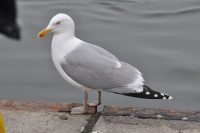You’d probably likes all these amazing herring gull facts. European herring gull (Larus argentatus) is one of the most well-studied gulls across Northern and Western Europe. They are one of the longest lived birds in the world with the maximum lifespan reaching up to 50 years in the natural habitat.
Herring Gull Facts for Kids
The upper plumage is grayish-black in color while the head and the underside are white. The wings are black at the end while there are also white patches. These white markings are called mirrors. On its yellow-colored bill, there is a red mark. The eye is surrounded by a light yellow ring. Its legs and webbed-feet are pink in color.
The size of a male herring gull is about 2 feet in length and weighs around 2.3 to 3.3 pounds while the length of a female (hen) European herring gull is 1.8 to 2 feet and weighs around 1.5 to 2.4 pounds. The size of its wingspan is around 4 to 5 feet and the length of its bill is 4.4 to 6.5 centimeters.
They are long-liv ed birds and tend to have a lifespan range of 32 to 49 years.
ed birds and tend to have a lifespan range of 32 to 49 years.
Breeding occurs in colonies of thousands and the maturity age for these birds is 5 years.
The hen of a European herring gull lays about 2 to 4 eggs on cliff ledges and incubates her eggs for about 28 to 30 days. The olive-shaded eggs have black spots over them. After the chicks are hatched out, it takes about 6 weeks for them to fledge. The parents continue to give food to their chicks for as long as 6 months.
The European herring gull is distributed all across Europe and Baltic states.
These herring gulls are opportunistic eaters. They tend to forage for dumping grounds, rubbish heap, leftovers, worms and chicks of birds. They also run off with the eggs and fledglings of other birds. Occasionally, the European herring gulls also dive down to a depth of not more than 6.6 feet to find aquatic prey. This kind of diving during flight is known as plunge diving.
The predators for the adult herring gulls are the seals and raptors. Among these, the peregrine and the gyrfalcons, the owls and the gray seals are the most common predators.





